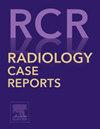Leriche syndrome: A closer look at a rare and critical aortoiliac occlusion
Q4 Medicine
引用次数: 0
Abstract
Collateral pathways in aortoiliac occlusive disease play a crucial role in maintaining blood flow to the abdomen, pelvis, and lower limbs. These pathways include systemic-to-systemic, visceral-to-visceral, and systemic-to-visceral connections. CT angiography is the primary imaging modality for diagnosing aortoiliac occlusion, offering detailed visualization of stenotic arteries and collateral pathways, particularly when enhanced by 3D reconstruction. This case report presents a 65-year-old male with poorly controlled hypertension, type 2 diabetes, and a 45-pack-year smoking history, who presented with progressively worsening claudication and rest pain. Imaging revealed thrombotic occlusion of the infrarenal aorta extending into the iliac arteries, with the development of collateral pathways. We also discuss the impact of erectile dysfunction severity and highlight evolving endovascular treatments such as CERAB, which show promising outcomes. This article aims to familiarize radiologists with the common patterns of aortoiliac occlusion and the associated collateral arterial pathways visible on CT angiography.
Leriche综合征:一个罕见的和严重的主动脉髂闭塞
主动脉髂闭塞疾病的侧支通路在维持血液流向腹部、骨盆和下肢方面起着至关重要的作用。这些通路包括系统到系统、内脏到内脏和系统到内脏的连接。CT血管造影是诊断主动脉髂闭塞的主要成像方式,可提供狭窄动脉和侧枝通路的详细可视化,特别是在3D重建增强后。本病例报告提出一名65岁男性,患有控制不佳的高血压、2型糖尿病和45包年的吸烟史,其表现为逐渐恶化的跛行和休息疼痛。影像学显示肾下主动脉血栓性闭塞延伸至髂动脉,伴侧枝通路发展。我们还讨论了勃起功能障碍严重程度的影响,并强调了不断发展的血管内治疗,如CERAB,显示出有希望的结果。本文旨在使放射科医师熟悉主动脉髂闭塞的常见模式以及CT血管造影显示的相关侧支动脉通路。
本文章由计算机程序翻译,如有差异,请以英文原文为准。
求助全文
约1分钟内获得全文
求助全文
来源期刊

Radiology Case Reports
Medicine-Radiology, Nuclear Medicine and Imaging
CiteScore
1.10
自引率
0.00%
发文量
1074
审稿时长
30 days
期刊介绍:
The content of this journal is exclusively case reports that feature diagnostic imaging. Categories in which case reports can be placed include the musculoskeletal system, spine, central nervous system, head and neck, cardiovascular, chest, gastrointestinal, genitourinary, multisystem, pediatric, emergency, women''s imaging, oncologic, normal variants, medical devices, foreign bodies, interventional radiology, nuclear medicine, molecular imaging, ultrasonography, imaging artifacts, forensic, anthropological, and medical-legal. Articles must be well-documented and include a review of the appropriate literature.
 求助内容:
求助内容: 应助结果提醒方式:
应助结果提醒方式:


